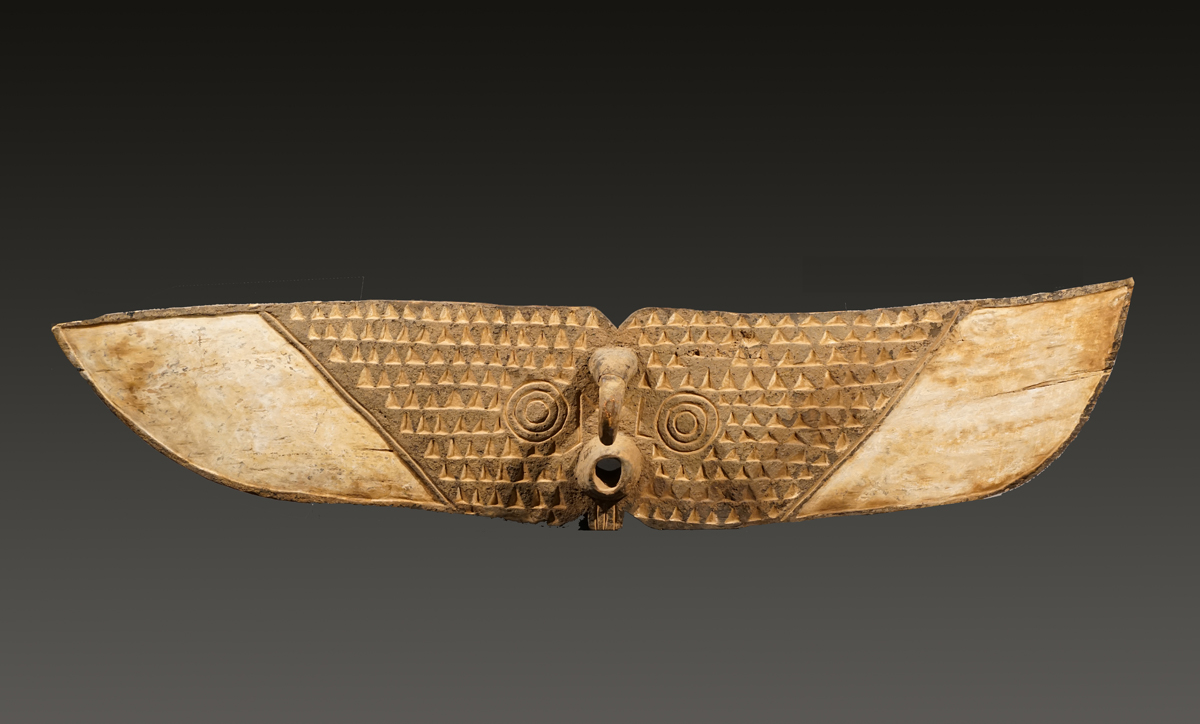|
A male Bwa butterfly mask, Bukina Faso, of highly abstract form, wide-spread wings decorated on each side of the front with triangular geometric patterns, the conical face with circular eyes and a rhoboide, protruding mouth and "nose"; fine aged patina with black and white pigments, waterdamages on each side of the mask; remarkable the asymetry of the wings, which underlines its "flying character", although it could be a lack of wood..but this is Africa: also butterflys with asymetric wings can fly. 1.600 -2.000,- Euro Length: 185 cm Roy (1987: 270) notes: "Bwa wooden masks represent a number of characters in the myths of their families and clans. Masks represent numerous animals including the antelope, bush buffalo, monkey [...], the crocodile and fish of several types [...] and insects including the butterfly [...]. The bird masks and butterflieds are the most abstract, consisting of a broad, horizontal plank, decorated with large concentric patterns. The mouth projects from the center and there [...are] circles representing the patterns on the butterfly's wings." Bwa masquerades draw upon the stylized features of humans, animals, and even insects. This mask is called duho, which means hawk (or sometimes duba, meaning vulture). The wings of the primarily two-dimensional hawk mask are usually simply decorated with white paint. The face of the hawk has been reduced to basic geometric forms. An inverted triangle defines the "face" and contains a protuberant, conical mouth and two sets of concentric circles for eyes. The outwardly projecting beak and the hook at the top of the face are two of the few elements that serve as a contrast to the overall planar nature of this nature spirit representation. Bold geometric shapes repeated in brightly painted designs are often added to enliven the surfaces of these relatively abstract forms. Bwa nature spirit masks are particularly impressive due to their commanding size and shape. This hawk mask's horizontal span extends nearly five feet wide; the wingspan of a related representation of the butterfly (yehoti) may be up to six or seven feet. Despite their daunting scale, these face masks are indeed worn by a performer, who bites on a thick fiber rope that passes through holes in the mask to secure it to his face. The mask is also attached to a fiber costume that covers the head and body of the performer. The choreography of the performance is derived from the movements and behavior of a hawk or vulture.
|
 photo: wolfgang-jaenicke.com, for more information, please write us an e-mail with the identification number of the photo identification no. GSC09037.jpg In Bwa society, the identity and continued well-being of a family are often tied to a nature spirit. The origin of this association may be a dream or even an encounter with a spirit who materializes in animal form. Upon consulting a priest, a family may commission a sculpture to embody that nature spirit. The masks appear at important funerals to honor the dead and escort their soul to the world beyond. They also dance at agricultural festivities to ensure the proper progression of the seasons, and at initiation rituals to help introduce young men and women to the secrets and responsibilities of adulthood. The masks are the object of family pride and are also an unofficial means of representing its prosperity and influence. Rival families will compete to assemble the most innovative and spectacular performances. Consequently, families will commission the carving of a multitude of masks—as many as nine different masks may represent an individual extended family. The elaborate decorations, the impressive size and design of the mask, as well as dynamic choreography all add to the grandeur and prestige of the event. Many traditional African religions have suffered in the twentieth century due to profound social changes resulting from colonialism, urbanization, and the spread of Islam. In spite of such developments, the majority of the Bwa have retained a core of religious and related artistic traditions that feature masks such as duho. Bwa religious life centers on the mythical figure of Do, an intermediary between the Bwa people and the Creator (Difini or Dobweni). Do represents the wild, uncultivated bush and its life-giving force, hence the emphasis on masks inspired by nature spirits such as the hawk, butterfly, or snake among others. Source: Metropolitan Museum of Art, New York The Michael C. Rockefeller Memorial Collection, Bequest of Nelson A. Rockefeller, 1979 (1979.206.196) |